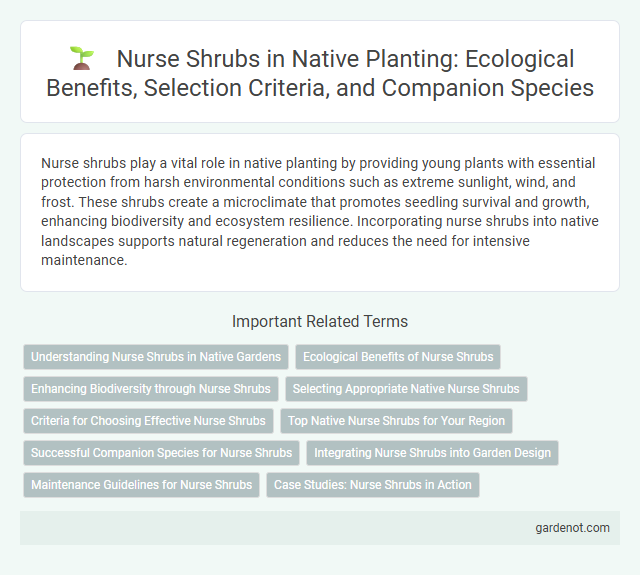Nurse shrubs play a vital role in native planting by providing young plants with essential protection from harsh environmental conditions such as extreme sunlight, wind, and frost. These shrubs create a microclimate that promotes seedling survival and growth, enhancing biodiversity and ecosystem resilience. Incorporating nurse shrubs into native landscapes supports natural regeneration and reduces the need for intensive maintenance.
Understanding Nurse Shrubs in Native Gardens
Nurse shrubs play a crucial role in native gardens by providing shelter, moisture retention, and protection for young plants during their early growth stages. These shrubs create a microenvironment that buffers harsh sun, wind, and temperature fluctuations, enhancing seedling survival rates. Essential species such as Ceanothus and Manzanita often serve as nurse shrubs due to their adaptability and ability to enrich soil through nitrogen fixation.
Ecological Benefits of Nurse Shrubs
Nurse shrubs enhance soil stability and increase moisture retention, creating a favorable microhabitat for native seedlings to establish and thrive. They support biodiversity by providing shelter and food resources for pollinators, birds, and small mammals within restoration sites. Their presence helps reduce erosion and improve nutrient cycling, accelerating ecosystem recovery in degraded landscapes.
Enhancing Biodiversity through Nurse Shrubs
Nurse shrubs play a crucial role in enhancing biodiversity by providing shelter, moisture retention, and nutrient-rich soil for native seedlings. Their presence creates microhabitats that support diverse insect and bird populations, promoting ecosystem resilience. Incorporating nurse shrubs such as Ceanothus or Manzanita facilitates successful reforestation and habitat restoration in native planting projects.
Selecting Appropriate Native Nurse Shrubs
Selecting appropriate native nurse shrubs involves considering species that thrive in local soil and climate conditions to support the growth of young plants. Native nurse shrubs like Ceanothus spp., Arctostaphylos spp., and Purshia tridentata provide essential shade, moisture retention, and protection from herbivores, promoting seedling establishment. Choosing shrubs with deep root systems and nitrogen-fixing abilities enhances soil fertility and long-term ecosystem stability.
Criteria for Choosing Effective Nurse Shrubs
Effective nurse shrubs thrive in native planting by prioritizing drought tolerance, soil stabilization abilities, and compatibility with local flora. Selecting species with dense canopies and deep root systems enhances seedling protection and nutrient cycling. Optimal nurse shrubs also exhibit resilience to pests and diseases, ensuring long-term support for emerging native plants.
Top Native Nurse Shrubs for Your Region
Top native nurse shrubs like Ceanothus, Aronia, and Shepherdia play a crucial role in supporting native plant ecosystems by providing shade, moisture retention, and protection for young seedlings. These shrubs enhance soil health through nitrogen fixation and attract beneficial pollinators that boost biodiversity. Selecting region-specific native nurse shrubs ensures optimal growth conditions, resilience to local pests, and long-term sustainability of your native garden.
Successful Companion Species for Nurse Shrubs
Successful companion species for nurse shrubs include native grasses, wildflowers, and nitrogen-fixing legumes that enhance soil health and moisture retention. These companions provide critical ground cover, reduce weed competition, and create a microhabitat that supports the nurse shrub's growth and survival. Selecting species that share similar soil and light requirements maximizes the symbiotic benefits and contributes to a resilient native planting ecosystem.
Integrating Nurse Shrubs into Garden Design
Nurse shrubs enhance garden design by providing essential shade and moisture retention for young native plants, promoting healthy growth. Integrating species like Ceanothus or Manzanita creates natural microclimates that support biodiversity and reduce maintenance needs. Strategic placement of nurse shrubs fosters soil stability and encourages native wildlife, making them vital components in sustainable landscaping.
Maintenance Guidelines for Nurse Shrubs
Nurse shrubs require minimal maintenance once established, with regular watering during dry periods to support young native plants. Mulching around the base helps retain moisture and suppress weeds, reducing competition for resources. Periodic pruning encourages healthy growth and improves air circulation, preventing disease and promoting a strong, resilient planting environment.
Case Studies: Nurse Shrubs in Action
Case studies highlight nurse shrubs like Ceanothus and Acacia significantly enhance native plant restoration by improving soil moisture and nutrient availability. In arid regions, these shrubs create microhabitats that support seedling survival rates up to 70% higher compared to open areas. Research from California chaparral ecosystems demonstrates increased native biodiversity and accelerated forest regeneration when nurse shrubs are strategically integrated.
Nurse shrub Infographic

 gardenot.com
gardenot.com